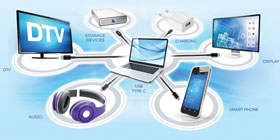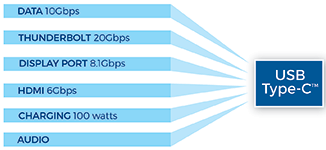

It could be argued that most standards have their time and place and, as technology moves on, so too must standards. Those that evolve with the ever changing market will stay ahead, while those that do not will eventually be consigned to the history books.
Since its introduction, USB has proven itself to be resilient and able to adapt to meet changing requirements. The latest iteration sees the introduction of the USB Type-C connector, which has the hallmarks of being a disruptive technology. To understand why, this article looks at the strengths of the USB standard, as well as the market conditions that are influencing its continued evolution.
Before the advent of USB there was a plethora of connector technologies that all offered advantages for specific applications. Topologies included serial and parallel busses in a variety of form factors and pin configurations. The result was there was no simple way of connecting multiple devices; no ‘plug and play.’ Each connector had its own protocol, each protocol required its own physical interface, and so peripherals were largely classified according to their interface.
The introduction of USB in 1996 brought standardisation to the physical interface thanks to a common connector and a driver that, really for the first time, offered a ‘plug and play’ user experience. It made it simpler to use multiple peripherals and at the same time ushered in significantly higher data transfer speeds, which was itself a significant development and one that heralded the future potential of the USB interface.
Connecting multimedia devices and storage solutions to a PC became easier, as did the transfer of large data files. It should also be noted that throughout its evolution the steering committee behind USB has vehemently supported backward compatibility, which has been a significant contributing factor to its longevity and overall appeal.
Power options in USB Type-C

The support that USB provides for power delivery is almost as important as its data transfer capabilities. Figure 1 shows the charging power capabilities of USB Type-C chargers. USB has become the ubiquitous method for charging portable devices and this will be further entrenched by the migration to the USB Type-C connector.
By standardising on the USB connector, manufacturers can offer both data and power over a single connection, and it also means that consumers can standardise on their power adaptors. While it took some years for mobile phone manufacturers to consolidate around the USB interface for power, the industry at large is expected to be much more willing to embrace the USB Type-C connector. This may be primarily due to its data capabilities, but the capacity to deliver much higher power levels will also be a significant factor.
High-speed digital transfer

With the introduction of the USB Type-C connector, USB is now in a position to displace nearly all other forms of interfaces in the consumer space, as shown in Figure 2.
Its support for power, raw data and multimedia interfaces such as HDMI and DisplayPort over a single cable will help propel USB into every home and onto every device.
The USB Type-C interface already supports DisplayPort 1.4 (at speeds of up to 8,1 Gbps) and HDMI 2.0 (at 6 Gbps), which means a USB 3.x connection can potentially provide both power and data transfer for a range of multimedia devices such as set-top boxes, digital projectors and even laptops and notebooks.
We are already seeing notebooks that only offer a USB Type-C interface, and while this massively simplifies the cables needed, it has also created a short- to mid-term demand for USB docking stations to support legacy equipment.
The introduction of SuperSpeed Plus USB with USB 3.1 Gen2, which operates at 10 Gbps, will also enable the USB interface to dominate in new application areas such as virtual reality (VR). This will greatly simplify the VR experience by replacing multiple connections for video, power and data with a single cable.
The higher data rates offered by USB 3.1 will make it easier to move HD content between computers and headsets, but this will also bring value to applications beyond the consumer vertical, such as industrial machine vision and imaging for the automotive market.
Many graphical applications, such as gaming, VR, machine vision, medical imaging, and automotive and autonomous vehicles, will need higher bandwidths for video content. This is often referred to as USB Type-C Generation 1 and USB Type-C Generation 2 – the key differences being speed.
Gen1 can support 5 Gbps, which is doubled to 10 Gbps in Gen2. Both Gen1 and Gen2 can support up to 100 Watts of power through the USB Type-C interface. Providing this level of power over a data cable will allow dedicated power ports to be removed from most notebooks and laptops, but it could also open up many new application areas for USB. This could extend to the area of home automation, for example, as well as industrial applications where higher power is needed.
Secure power through USB Type-C

This level of power delivery becomes significant, so it is reassuring to know that the USB Implementers Forum is working hard toward the certification of USB chargers. This extends to a logo indicating the power capabilities of the charger in terms of Watts at the output, as shown in Figure 3.
The delivery of power is actually handled over a dedicated communications channel on the USB Type-C connector, which uses a messaging protocol to allow devices to negotiate over the power they need and the direction it will flow. These measures are also intended to combat the potential threat of counterfeit chargers entering the market, with a commitment to prosecute perpetrators whenever possible.
Implementing USB Type-C
The new capabilities of USB 3.x over USB Type-C introduce additional design challenges for developers. For example, when two devices connect, they need to arbitrate over which is the host and which is the device; potentially they could both support dual-role mode, which means they can operate as either host or device.
For example, a tablet could be a host to a memory stick but a device to a PC. The negotiation will extend to whether the connection will support data only, or data and an alternate mode such as video. It will also include power requirements, such as whether or not the host/device needs to sink or source power.
Other considerations will include exchanging information about what data speeds are needed and/or supported, and whether the host/device is Gen1 or Gen2 compliant, for example.
The configuration of the connection must also be considered; the USB Type-C plug is designed to be inserted into a socket either way, so there is no ‘up’ or ‘down.’ To overcome this, a multiplexer will typically be used to flip the connections, and if both data and video are to be supported it may be necessary to include a crossbar switch, in order to direct the correct connections to the right pins.
This is because there are three modes available: data only, data plus two lanes of DisplayPort, or four lanes of DisplayPort. All of these design aspects are provided through a dedicated USB Type-C port controller. This would operate alongside a power switch capable of delivering up to 20 V at 5 A (100 W).
For some applications, such as VR, it may also be necessary to include a multiplexer to switch in the SuperSpeed channel, to provide SuperSpeed USB alongside four lanes of DisplayPort. A signal redriver may also be required; this allows for longer spans between the interface and the controller by providing up to 10 dB of noise margin to the channel budget, which can help mitigate signal integrity concerns.

A diagram of a USB Type-C solution with relevant offerings by Diodes Incorporated is shown in Figure 4. Active cables will also be prevalent, which would have repeaters embedded within them. The speed of the data passing through the cable, so close to power, will inevitably introduce transients.
Diodes Incorporated offers a variety of transient voltage suppressors (TVS) that can meet the stringent load capacitance limitations imposed on the SuperSpeed signal, for example. With a dedicated TVS for each of the signals present in USB Type-C, including SuperSpeed as well as power, Diodes is a leader in this domain.
This is going to become more important as we transition from USB 3.1 to USB 3.2, at which point the simultaneous use of the currently unused data lanes will see speeds increasing to 40 Gbps; four lanes of 10 Gbps. When operating alongside DisplayPort or Thunderbolt channels, the aggregate speeds through a USB cable will reach 80 Gbps.
Managing this level of power and data transfer will put increased pressure on developers, who will need the support of leading solution providers such as Diodes Incorporated in order to meet that challenge.
Conclusion
While USB has been around for over 20 years, it shows no signs of ageing. The enablement of SuperSpeed is just one reason why we can expect the USB interface to dominate for many years to come, but power delivery must also be a major factor in that.
As USB Type-C will be able to support 4K and 8K video, alongside 100 W of power, it is destined to be adopted by a wider range of applications across all market sectors. This will encourage more suppliers into the market and increase the availability of highly integrated solutions, bringing greater competition and consumer choice.
It will be necessary for developers to understand and evaluate these potential solutions in order to achieve their design goals. For this reason, choosing the right design partner will be both a technical and a commercial necessity. With its extensive and growing portfolio of USB 3.x USB Type-C solutions, including dedicated TVSs, port controllers and redrivers, Diodes Incorporated is well placed to be a partner of choice.
| Tel: | +27 11 923 9600 |
| Email: | [email protected] |
| www: | www.altronarrow.com |
| Articles: | More information and articles about Altron Arrow |
© Technews Publishing (Pty) Ltd | All Rights Reserved